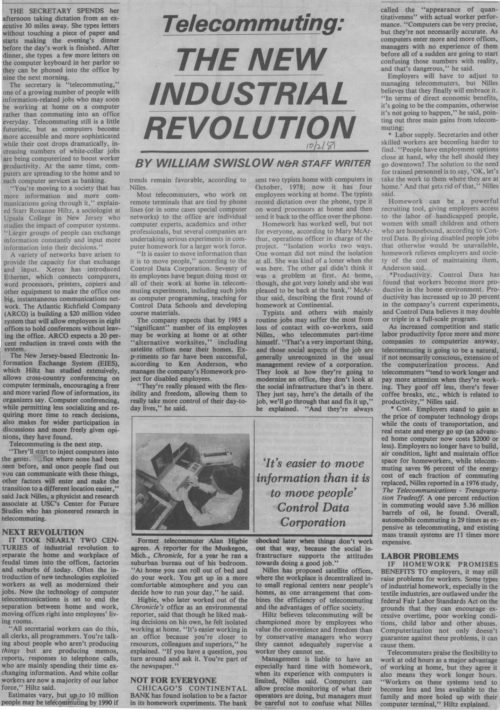
With a grip on the zeitgeist that is shaky at best, I rarely find myself ahead of big trends. But at least once I can claim to have been a halfway decent futurist. This 1981 piece describing the future of work was distributed by Columbia Journalism School’s news service to a handful of small newspapers. A version later appeared in the Santa Barbara News & Review, the first place I worked professionally.
At the time the idea of office workers being employed at home was not widely foreseen, but I had come across a news item on a pilot program at Continental Bank in Chicago. It interested me mostly because of the history of homework prior to the industrial revolution; I wondered what its possible revival would mean in a modern economy.
Anyway, here’s the original story, working from home seen through a glass darkly, 40 years before a combination of technological advances and a pandemic made it ubiquitous.
The secretary spends her afternoon taking dictation from an executive 30 miles away. She types letters without touching a piece of paper and starts making the evening’s dinner before the day’s work is finished. After dinner, she types a few more letters on the computer keyboard in her parlor so they can be phoned into the office by nine the next morning.

The secretary is “telecommuting,” one of a growing number of people with information-related jobs who may soon be working at home on a computer rather than commuting into an office every day. Telecommuting still is a little futuristic, but as computers become more accessible and more sophisticated while their cost drops dramatically, increasing numbers of white-collar jobs are being computerized to boost worker productivity. At the same time, computers are spreading to the home and to such services as banking.
“You’re moving to a society that has more information and more communications going through it,” explained Starr Roxanne Hiltz, a sociologist at Upsala College in New Jersey who studies the impact of computer systems. “Larger groups of people can exchange information constantly and input more information into their decisions.”
A variety of networks have arisen to provide the capacity for that exchange and input. Xerox has introduced Ethernet, which connects computers, word processors, printers, copiers and other equipment to make the office one big, instantaneous communications network. The Atlantic Richfield Company (ARCO) is building a $20 million video system that will allow employees in eight offices to hold conferences without leaving the office. ARCO expects a 20 percent reduction in travel costs with the system.
The New Jersey-based Electronic Information Exchange System (EIES), which Hiltz has studied extensively, allows cross-country conferencing on computer terminals, encouraging a freer and more varied flow of information, its organizers say. Computer conferencing, while permitting less socializing and requiring more time to reach decisions, also makes for wider participation in discussions and more freely given opinions, they have found.
Telecommuting is the next step. “They’ll start to inject computers into the general office where none had been seen before, and once people find out you can communicate with these things, other factors will enter and make the transition to a different location easier,” said Jack Nilles, a physicist and research associate at USC’s Center for Future Studies who has pioneered research in telecommuting.
Next Revolution
It took nearly two centuries of industrial revolution to separate the home and workplace of feudal times into the offices, factories and suburbs of today. Often the introduction of new technologies exploited workers as well as modernized their jobs. Now the technology of computer telecommunications is set to end the separation between home and work, moving offices right into employees’ living rooms.
“All secretarial workers can do this, all clerks, all programmers. You’re talking about people who aren’t producing things but are producing memos, reports, responses to telephone calls, who are mainly spending their time exchanging information. And white-collar workers are now a majority of our labor force,” Hiltz said.
Estimates vary, but up, to 10 million people may be telecommuting by 1990 if trends remain favorable, according to Nilles.
Most telecommuters, who work on remote terminals that are tied by phone lines (or in some cases special computer networks) to the office are individual computer experts, academics and other professionals, but several companies are undertaking serious experiments in computer homework for a larger work force.
“It is easier to move information than it is to move people,” according to the Control Data Corporation. Seventy of its employees have begun doing most or all of their work at home in telecommuting experiments, including such jobs as computer programming, teaching for Control Data Schools and developing course materials.
The company expects that by 1985 a “significant” number of its employees may be working at home or at other “alternative worksites,” including satellite offices near their homes. Experiments so far have been successful, according to Ken Anderson, who manages the company’s Homework project for disabled employees.
“They’re really pleased with the flexibility and freedom, allowing them to really take more control of their day-to-day lives,” he said.
Former telecommuter Alan Higbie agrees. A reporter for the Muskegon, Mich., Chronicle, for a year he ran a suburban bureau out of his bedroom. “At home you can roll out of bed and do your work. You get up in a more comfortable atmosphere and you can decide how to run your day,” he said.
Higbie, who later worked out of the Chronicle’s office as an environmental reporter, said that though he liked making decisions on his own, he felt isolated working at home. “It’s easier working in an office because you’re closer to resources, colleagues and superiors,” he explained. “If you have a question, you turn around and ask it. You’re part of the newspaper.”
Not for Everyone
Chicago’s Continental Bank has found isolation to be a factor in its homework experiments. The bank sent two typists home with computers in October, 1978; now it has four employees working at home. The typists record dictation over the phone, type it on word processors at home and then send it back to the office over the phone.
Homework has worked well, but not for everyone, according to Mary McArthur, operations officer in charge of the project. “Isolation works two ways. One woman did not mind the isolation at all. She was kind of a loner when she was here. The other gal didn’t think it was a problem at first. At home, though, she got very lonely and she was pleased to be back at the bank,” McArthur said, describing the first round of homework at Continental.
Typists and others with mainly routine jobs may suffer the most from loss of contact with co-workers, said Nilles, who telecommutes part-time himself. “That’s a very important thing, and those social aspects of the job are generally unrecognized in the usual management review of a corporation. They look at how they’re going to modernize an office, they don’t look at the social infrastructure that’s in there. They just say, here’s the details of the job, we’ll go through that and fix it up,” he explained. “And they’re always shocked later when things don’t work out that way, because the social infrastructure supports the attitudes towards doing a good job.”
Nilles has proposed satellite offices, where the workplace is decentralized into small regional centers near people’s homes, as one arrangement that combines the efficiency of telecommuting and the advantages of office society.
Hiltz believes telecommuting will be championed more by employees who value the convenience and freedom than by conservative managers who worry they cannot adequately supervise a worker they cannot see.
Management is liable to have an especially hard time with homework when its experience with computers is limited, Nilles said. Computers can allow precise monitoring of what their operators are doing, but managers must be careful not to confuse what Nilles
called the “appearance of quantitativeness” with actual worker performance. “Computers can be very precise, but they’re not necessarily accurate. As computers enter more and more offices, managers with no experience of them before all of a sudden are going to start confusing those numbers with reality, and that’s dangerous,” he said.
Employers will have to adjust to managing telecommuters, but Nilles believes that they finally will embrace it. “In terms of direct economic benefits, it’s going to be the companies, otherwise it’s not going to happen,” he said, pointing out three main gains from telecommuting:
- Labor supply. Secretaries and other skilled workers are becoming harder to find. “People have employment options close at hand, why the hell should they go downtown? The solution to the need for trained personnel is to say, ‘OK, let’s take the work to them where they are at home.’ And that gets rid of that,” Nilles said.
- Homework can be a powerful recruiting tool, giving employers access to the labor of handicapped people, women with small children and others who are housebound, according to Control Data. By giving disabled people jobs that otherwise would be unavailable, homework relieves employers and society of the cost of maintaining them, Anderson said.
- Productivity. Control Data has found that workers become more productive in the home environment. Productivity has increased up to 20 percent in the company’s current experiments, and Control Data believes it may double or triple in a full-scale program.
- As increased competition and static labor productivity force more and more companies to computerize anyway, telecommuting is going to be a natural, if not necessarily conscious, extension of the computerization process. And telecommuters “tend to work longer and pay more attention when they’re working. They goof off less, there’s fewer coffee breaks, etc., which is related to productivity,” Nilles said.
- Cost. Employers stand to gain as the price of computer technology drops while the costs of transportation, real estate and energy go up (an advanced home computer now costs $2000 or less). Employers no longer have to build, air condition, light and maintain office space for homeworkers, while telecommuting saves 96 percent of the energy cost of each fraction of commuting replaced, Nilles reported in a 1976 study, The Telecommunications – Transportation Tradeoff. A one percent reduction in commuting would save 5.36 million barrels of oil, he found. Overall, automobile commuting is 29 times as expensive as telecommuting, and existing mass transit systems are 11 times more expensive.
Labor Problems
If homework promises benefits to employers, it may still raise problems for workers. Some types of industrial homework, especially in the textile industries, are outlawed under the federal Fair Labor Standards Act on the grounds that they can encourage excessive overtime, poor working conditions, child labor and other abuses. Computerization not only doesn’t guarantee against these problems, it can cause them.
Telecommuters praise the flexibility to work at odd hours as a major advantage of working at home, but they agree it also means they work longer hours. “Workers on these systems tend to become less and less available to the family and more holed up with their computer terminal,” Hiltz explained.
Many of the questions posed by computer homework will become apparent only as this new form of cottage industry spreads. Homework’s promise of lower capital and transportation costs, improved productivity, more flexibility for employees and access to more — and perhaps cheaper — workers for employers, though, mean that computer homework may not be a futuristic concept for long.

An interesting idea indeed. And we’ll reported you boot.